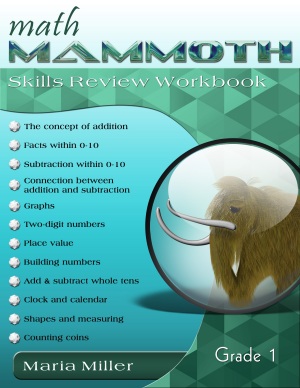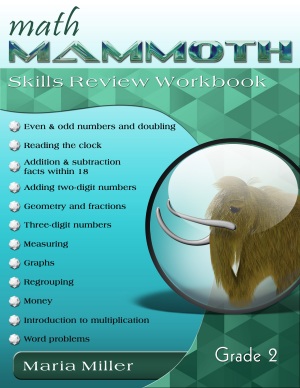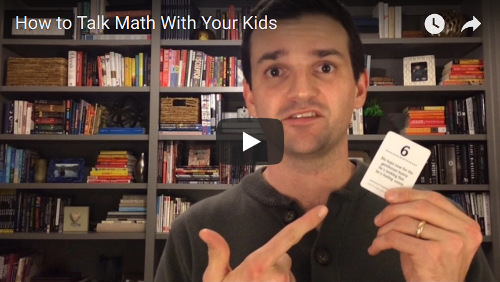
Maria's Math News, September 2017 |
|
Hi again! And welcome back to school, if you've started your homeschool year here recently. In this edition:
|
1. Math Mammoth newsWe have some totally NEW products!Math Mammoth skills review workbooks have been designed to complement the lessons in Math Mammoth complete curriculum (Light Blue series). These books are designed to provide a spiral review of the concepts in the curriculum, and to be used during the school year, alongside the main curriculum. After a concept or skill has been studied in the main curriculum, it is then reviewed repeatedly over time in several different worksheets of the workbook. Each book contains 70-100 worksheets, and is divided into chapters, according to the corresponding chapters in the Math Mammoth curriculum. Each worksheet is designed to be one page, and includes a variety of exercises in a fun way without becoming too long and tedious. You can choose exactly when to use the worksheets within the chapter, and how many of them to use. Not all students need all of these worksheets to help them keep their math skills fresh, so please vary the amount of worksheets you assign your student(s) according to their needs. Currently, we have the books for grades 1-2 available, and grade 3 is coming SOON. => Learn more here. Rainbow Resource Center will run a sale on Math Mammoth printed books from September 12 through September 18. Would you need the ANSWER KEYS only (to the Light Blue series), as a download? If so, we have you covered. Math Mammoth supportive materials products contain, not only the answer keys, but also the tests and additional cumulative reviews, the worksheet maker, and Soft-Pak, for each grade of the Math Mammoth Light Blue series. They are designed for those who purchase the actual student texts as printed books. |
2. Giveaway: Science DVDsI have something extra-special for you. I've arranged with Supercharged Science to give away...
CLICK this link now to access the free lesson and enter the giveaway PLUS, as an added gift, you'll get a free hands-on science lesson video "How to create Instant Ice" that you can do today with stuff you already have at home. Aurora's science videos are top-notch! My girls have watched a bunch in the past and enjoyed them a lot. Now I'm starting my son on them and he is fascinated because they are so hands-on. We have made a sundial and a thermometer, simulated a solar eclipse, and more! To get your free science lesson on "How to Create Instant Ice" and to register for this rather unique free giveaway, click this link: http://www.superchargedscience.com/opt/math-mammoth-instant-ice-opt-esci-09-2017/ |
3. When to use flash cardsSomeone asked this recently, and it's a VERY good question!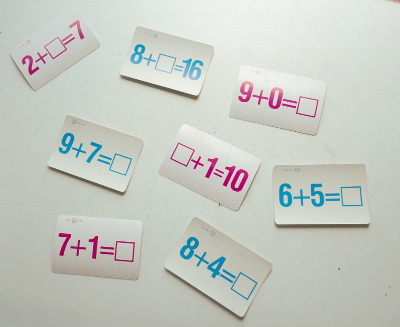 "Hi Maria! We will be using MM for the first time starting next month (light blue grade 1) and I was wondering if there is any recommendation of when to work on addition facts/flashcards throughout the worktexts, or if we just do that on our own with the appropriate lessons? We're switching from A Beka, which was flashcard heavy and had it all scripted, so I'm just trying to make sure I'm doing it correctly :) Thanks!" Like I said, this is a GOOD question. :) Math Mammoth is not scripted. It allows you to be creative in your teaching and adapt things to your child in various ways. For example, you're not limited to study only in one chapter at a time. If your child does better by studying 2-3 topics at a time, feel free to have them work in 2-3 chapters at a time (though, some chapters because of their topics are best studied in the order they appear in the book, but usually you have liberty to study clock, measuring, geometry, and money at most any time you wish). Also, I've always advocated the thought that the MOST CRUCIAL element in instruction is NOT the book, but the teacher, and that we shouldn't ever become "slaves" to the books, not even to Math Mammoth books. The best possible situation is when the instruction is tailored to the student's individual needs. Your Math Mammoth book is just a tool you can use to help teach your child. You as the teacher are still in total control, and you have the liberty to decide IF to use flash cards, and WHEN to use them. Children's needs are so variable that I really don't want to dictate when a child should review addition facts, or how. The curriculum does provide a list of online games and resources for that purpose (in the introduction of each chapter). You may use flashcards if you find them effective and if they don't cause math anxiety. However, I don't want to put too much emphasis on flashcards, because too many adults have, because of their experiences in school, ended up viewing mathematics as "flashcards, speed tests, and memorization of rules" — which it is NOT! We should emphasize the notion that there are MANY ways to come up with the answer, and that the thinking processes, strategies, and patterns are more important than successfully and quickly producing the correct answer. That said, it is definitely very helpful to know all your addition facts by memory — but it is even more important to learn a set of strategies for mental addition, because that "number sense" (being able to break apart and combine numbers in various ways in order to calculate something) is a crucial skill in order to succeed in mathematics. Hope this helps! |
4. How to talk math with your kids - videoKent Haines is both a math teacher and a dad. In this video, he shares some excellent tips on how to help your children's "math-readiness", expressing it with a modern term. Or we might just say, how to help your children understand their world with math. It's aimed at parents of little children but the ideas ring true for other ages too: The three important guidelines he shares are: 1. Use math language. 2. Play. 3. Focus on questions, not on answers. Go check it out! I enjoyed the video! |
2. Giveaway: Science DVDsI have something extra-special for you. I've arranged with Supercharged Science to give away...
CLICK this link now to access the free lesson and enter the giveaway PLUS, as an added gift, you'll get a free hands-on science lesson video "How to create Instant Ice" that you can do today with stuff you already have at home. Aurora's science videos are top-notch! My girls have watched a bunch in the past and enjoyed them a lot. Now I'm starting my son on them and he's been fascinated because they are so hand-son. We recently made a sundial and a thermometer, and now he wants us to build an anemometer! To get your free science lesson on "How to Create Instant Ice" and to register for this rather unique free giveaway, click this link: http://www.superchargedscience.com/opt/math-mammoth-instant-ice-opt-esci-08-2017/ |
5. Babylonian tablet with simpler trigonometry than our own This is fascinating!
This is fascinating!
An ancient Babylonian tablet contains the world's oldest trigonometric table; but not only that.... it is also a MORE ACCURATE trigonometric table than modern ones, because of the very different Babylonian approach to arithmetic and geometry (using the base 60 instead of base 10). This tablet uses simpler, yet more accurate trigonometry that has clear advantages over our own modern version. It's based on ratios instead of angles and circles. It is rare that an ancient discovery could be teaching today's mathematicians something new but that seems to be the case here! I'm sure many students would welcome a simpler approach to trigonometry! |
6. Thoughts on technology and how to teach those who don't love math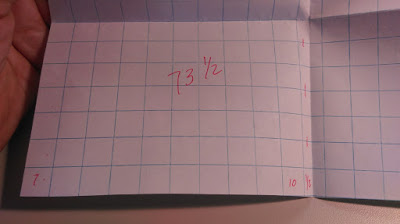 If you have a few minutes, check out
Representations and Manipulatives and Tools and Things.
If you have a few minutes, check out
Representations and Manipulatives and Tools and Things.
It's an interesting and encouraging read. Thoughts about technology (no need for it at every turn), and how to teach those who don't love math, and how just a piece of graph paper can lend itself to a powerful learning tool...! Thanks for reading! Feel free to forward this issue to a friend/colleague! Subscribe here. Till next time, Maria Miller |
| Math Mammoth freebies | Math Mammoth on Facebook | Newsletter Archives |
| Inspire4 | Complete curriculum | Placement tests |
